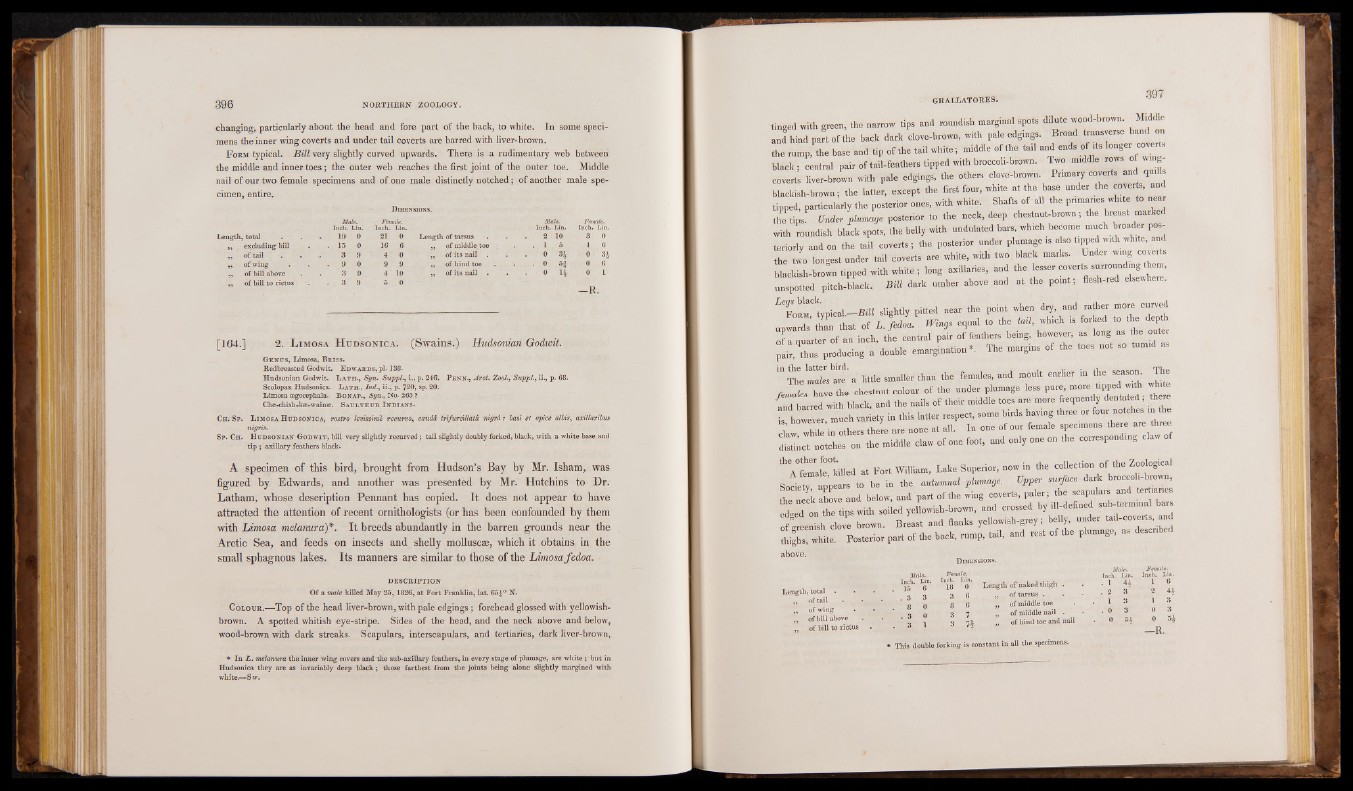
changing, particularly about the head and fore part of the back, to white. In some specimens
the inner wing coverts and under tail coverts are barred with liver-brown.
Form typical. Bill very slightly curved upwards. There is a rudimentary web betweeii
the middle and inner toes; the outer web reaches the first joint of the outer toe. Middle
nail of our two female specimens and of one male distinctly notched; of another male specimen,
entire.
Dimensions.
Length, total
Male Inch. Li. n.
19 0
Female.
Inch. Lin .
21 0 Length of tarsus
Male. ■ Inch. Lin.
2 10
Female. Inch. Lin.
3 0
,, excluding bill . . 15 0 16 6 of middle, toe • 1 5 1 6
„ of tail • • 3 9 4 0 „ of its nail . : o 34 0 34
,, - of wing . 9 0 9 .9 ,, of hind toe . . 0 5f • 0 6
,, of bill above 3 9 4 10 „ of its nail . 0 1£ 0 1
,, of bill to rictus 3 9 5 0 — R .
[164.] 2. L im o sa H u d s o n ic a . (Swains.) Hudsoniari Godwit.
Ge n u s , Limosa, B r is s .
Redbreasted Godwit. E dwards, pi. 138.
Hudsonian Godwit. L a th ., Syn. Supply i., p. 246. P e n n ., Arct. Zool., Supply ii., p. 68.
Scolopaz Hudsonica. L a th ., Ind., ii., p. 720, sp. 20.
Limosa segocephala. B o nap., Syn., No. 265 ?
Che-chish-kae-wain£e. Sa u x t e u r I n d ia n s.
Ch ; Sp . L im osa H udsonica, rostro levissime recurvo, caudd irifu rd lla ta nigrd: basi et apice albis, axillaribus
nigris.
Sp . Ch . H u d so n ia n Go dw it , bill very slightly recurved; tail slightly doubly forked, black, with a white base and
tip ; axillary feathers black.
A specimen of this bird, brought from Hudson’s Bay by Mr. Isham, was
figured by Edwards, and another was presented by Mr. Hutchins to Dr.
Latham, whose description Pennant has copied. It does not appear to have
attracted the attention of recent ornithologists (or has been confounded by them
with Limosa melanura)*. It breeds abundantly in the barren grounds near the
Arctic Sea, and feeds on insects and shelly molluscs, which it obtains in the
small sphagnous lakes. Its manners are similar to those of the Limosa fedoa.
DESCRIPTION
Of a male killed May 25, 1826, at Fort Franklin, lat. 65 J° N.
C olour.—Top of the head liver-brown, with pale edgings ; forehead glossed with yellowish-
brown. A spotted whitish eye-stripe. Sides of the head, and the neck above and below,
wood-brown with dark streaks. Scapulars, interscapulars, and tertiaries, dark liver-brown,
* In L. melanura the inner wing covers and the sub-axillary feathers, in every stage of plumage, are white; but in
Hudsonica they are as invariably deep black; those farthest from the joints being alone slightly margined with
white«—Sw.
tinged with green, the narrow tips and roundish marginal spots dilute wood-brown. Middle
and hind part of the back dark clove-brown, with pale edgings. Broad transverse band on
the rump, the base and tip of the tail whitefl middle of the tail and ends of its
black; central pair of tail-feathers tipped with broccoli-brown. Two middle rows of wi g-
coverts liver-brown with pale edgings, the others clov«-brown. Primary coverts and quills
blackish-brown; the latter, except the first four, white at the base under the cover s, and
tipped, particularly the posterior ones, with white. Shafts of all the primaries white to near
the tips- Under plumage posterior to the neck, deep chestnut-brown; the breast marked
with roundish black spots, the belly with undulated bars, which become much broader posteriorly
and on the tail coverts ; the posterior under plumage is also tipped with white, and
the two longest Under tail coverts are white, with two black marks. Under wing coverts
blackish-brown tipped with white I long axillaries, and the, lesser coverts surrounding them,
unspotted pitch-black. Bill dark umber above and at the point; flesh-red elsewhere.
pitted near the point when dry, and rather more curved
upwards than that of L. fedoa. Wings equal to the tail, which is forked to the depth
of a.quarter of an inch, the central pair of feathers being, however, as long as thejmte
pair, thus producing a'double emarginatiou*. The margius of the toes not
m Tim males^are' a little smaller than the females, and moult earlier in the seasom The
M M have the chestnut colour of the under plumage less pure, more tipped with white
f Clack and the nails of their middle toes are more frequently dentated , there
■ however much variety in this latter respect, some birds having three or four notches in the
claw while in others thele are none at all. In one of our female specimens there are three
d i e t notches on the middle claw of one foot, and only one on the corresponding claw of
at Fort William, Lake Superior, now in the collection of the Zoological
Sodety appears to be in the autumnal plumage. Upper surface dark broccoli-brown,
the n ck above and below, and part of the wing coverts, paler; the scapulars and tertiaries
Idged on the tips with soiled yellowish-brown, and crossed by ill-defined sub-term,nal bars
g i ish clove brown. Brlast and flanks yellowish-grey; belly, under ta,1-coverts, an
th ig h ihite. Posterior part of the back, rump, tail, and rest of the plumage, as described
above. Dimensions.
Length, total .
Length of naked thigh
,, of tail . ,
of tarsus. .
„ of wing
,, of middle toe
,, of bill above
„ of middle nail
This double forking is constant in all the specimens.